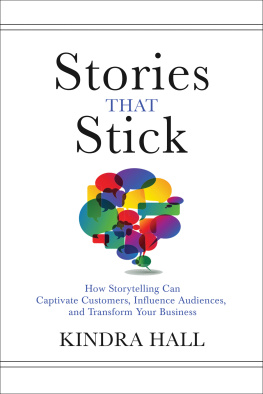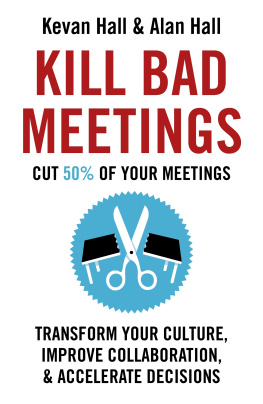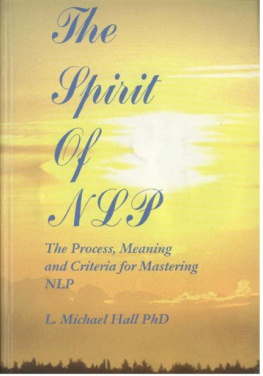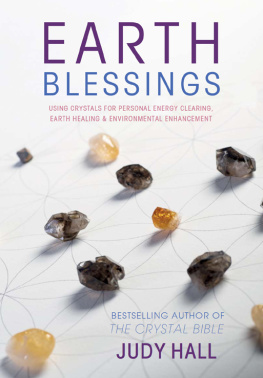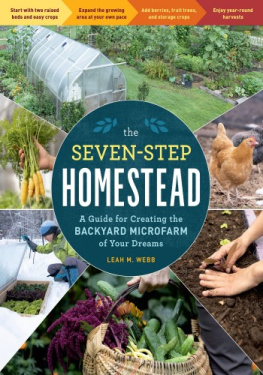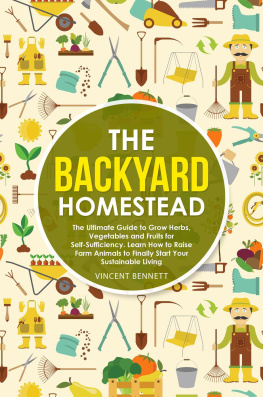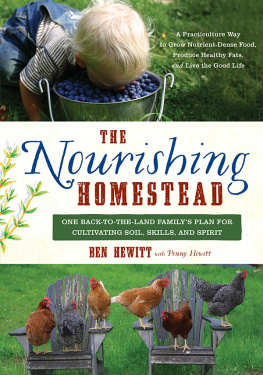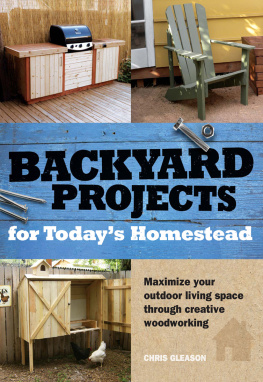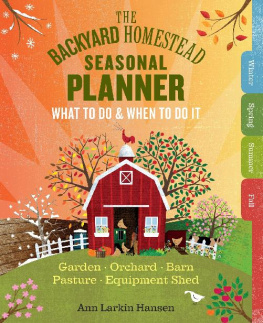The Dreamers Homestead Garden
6 Simple Steps from Plan to Produce for Self Sufficiency
Sophia Hall
easygreenguides
Contents
Copyright easygreenguides 2021 - All rights reserved
The content contained within this book may not be reproduced, duplicated or transmitted without direct written permission from the author or the publisher.
Under no circumstances will any blame or legal responsibility be held against the publisher, or author, for any damages, reparation, or monetary loss due to the information contained within this book. Either directly or indirectly. You are responsible for your own choices, actions, and results.
Legal Notice:
This book is copyright protected. This book is only for personal use. You cannot amend, distribute, sell, use, quote or paraphrase any part, or the content within this book, without the consent of the author or publisher.
Disclaimer Notice:
Please note the information contained within this document is for educational and entertainment purposes only. All effort has been executed to present accurate, up to date, and reliable, complete information. No warranties of any kind are declared or implied. Readers acknowledge that the author is not engaging in the rendering of legal, financial, medical or professional advice. The content within this book has been derived from various sources. Please consult a licensed professional before attempting any techniques outlined in this book.
By reading this document, the reader agrees that under no circumstances is the author responsible for any losses, direct or indirect, which are incurred as a result of the use of the information contained within this document, including, but not limited to, errors, omissions, or inaccuracies.
The glory of gardening: hands in the dirt, head in the sun, heart with nature. To nurture a garden is to feed not just the body, but the soul. Alfred Austin
Years ago, I moved with my husband to a small town in the Oklahoma Panhandle. We settled down in a modest three-bedroom bungalow with a fenced-in backyard full of yellowing grass. We stared at that space, trying to decide what to do with it. When spring came around, our neighbors sprang to life and our neighborhood became a flurry of activity.
Our minds were blown at how busy our stretch of street became once the weather started warming up. Over white picket fences, I could see families in various yoga-like poses, working the soil. I chatted with a few of them, who were all too eager to show me photos of their fat tomatoes and juicy strawberries. The most exciting part of their yearly planting tradition was that they ate what they grew themselves and shared the surplus with each other. This inspired me with an idea: Why dont we plant fruits, vegetables, flowers, and more in our own backyard? And that is how I ended up starting my own homestead garden. That was almost a decade ago.
Gardening adds years to your life and life to your years. Unknown
It is easy to stroll into a supermarket and fill carts with fruits and vegetables, so why grow your own? It was not a hard sell to my husband and me. The reasons that drew us to homesteading were as important to us then as they are now. For me, homesteading is about more than saving $0.50 on radishes every time I go grocery shopping (although that is nice). It's about being self-reliant, connected to nature, and all-around just living a simpler life. There is something fulfilling about growing your own food; it's almost like our ancestors have been doing it for thousands of years! We ate what we tended ourselves, so we knew what we were putting into our bodies. We were happy to get our hands dirty and get some exercise outside with the wind on our faces. You are healthier, and you swipe your credit card less at the grocery store. Time spent tending the homestead is also quality family bonding time. Of course, gardening has many other benefits, but these are the ones that resonate the most with me.
Food is a cornerstone of self-sufficiency. One thing I learned from years of being a teacher: no matter how great your skillset or how wonderful the subject is, if a pupil's stomach is empty, they won't hear a thing you say. They cannot think. They cannot play. They cannot learn. Transpose that to your experience as an adult, and you get the drift.
Sometimes the unexpected happens and nasty surprises get thrown your way. One March weekend, we had a horrible storm that hung icicles on trees and blew out electrical grids. Most grocery stores in our town had to throw dumpsters' worth of foodstuff as their coolers transformed into warmers. Frantic hoarders wiped out the rest of the shelves. Our family's saving grace was that we still had enough preserves and fresh food from our winter garden. Even our neighbors had their own supplies to tide them over until power came back three days later. Homesteading gives you that kind of resilience and more.
I know homesteading can sound a bit daunting and exclusive to a particular group of people, but trust me when I say that you really don't need anything extraordinary to do it. Like most life skills in the world, it's just a matter of will and practice. Perfecting it can take a long time, but you shouldn't feel embarrassed to call yourself a homesteader at zero logged hours. Assume that identity from the get-go and learn along the way. It is a mindset and an attitude that you simply need to imbibe.
Homesteading doesn't require you to spend all day in the backyard. You should still be able to work your nine-to-five. There is no such thing as a stereotype homesteader - anybody can be one. Just start with one small step. You will eventually build up the momentum to do so much more than that.
I titled the book The Dreamers Homestead Garden: Six Simple Steps from Plan to Produce for Self-Sufficiency because I recognize that you've dreamed of growing your own food for a long time now. This book is written for you. I have made the steps and the language as simple as possible to push you gently out the door, leaving you no excuses not to carry on, on your own. You will not get everything perfect the first time. You will make many mistakes. However, the point is not to focus on the negatives.
There are no gardening mistakes, only experiments. Janet Kilburn Phillips
To dream is to aspire for something that is yet to come. All it takes to get there is one small step at a time. Let your dream of a homestead garden begin here. I will hold your hand through six steps, taking you from plan to produce!
A Note on Sustainaibility
As much as possible, make your homestead garden a laboratory of sorts for waste management. Be mindful of the three Rs: reduce, reuse, and recycle. Be creative in using old and used items for your projects. Early on, I discovered that the town's hardware stores threw out their wooden pallets used for delivering goods. They gave me permission to collect dozens of them from their dumpsters to make raised plant beds, fences, and trellises. Then, a friend who worked at a tire center donated several old tires for protection against the notorious Oklahoma tornado winds.
I also repurposed plastic items (water bottles, cracked food containers, etc.) as pots, tubes, posts, blocks, and more. Just be sure to check under each container for their number type. Numbers 2, 4, and 5 (surrounded by the recycling symbol) may be reused or recycled in your garden as long as their original contents were also food-grade. Number 1 containers are also viable candidates but do not expose them to direct and extreme heat or light. Use them in the shade or your shed.


